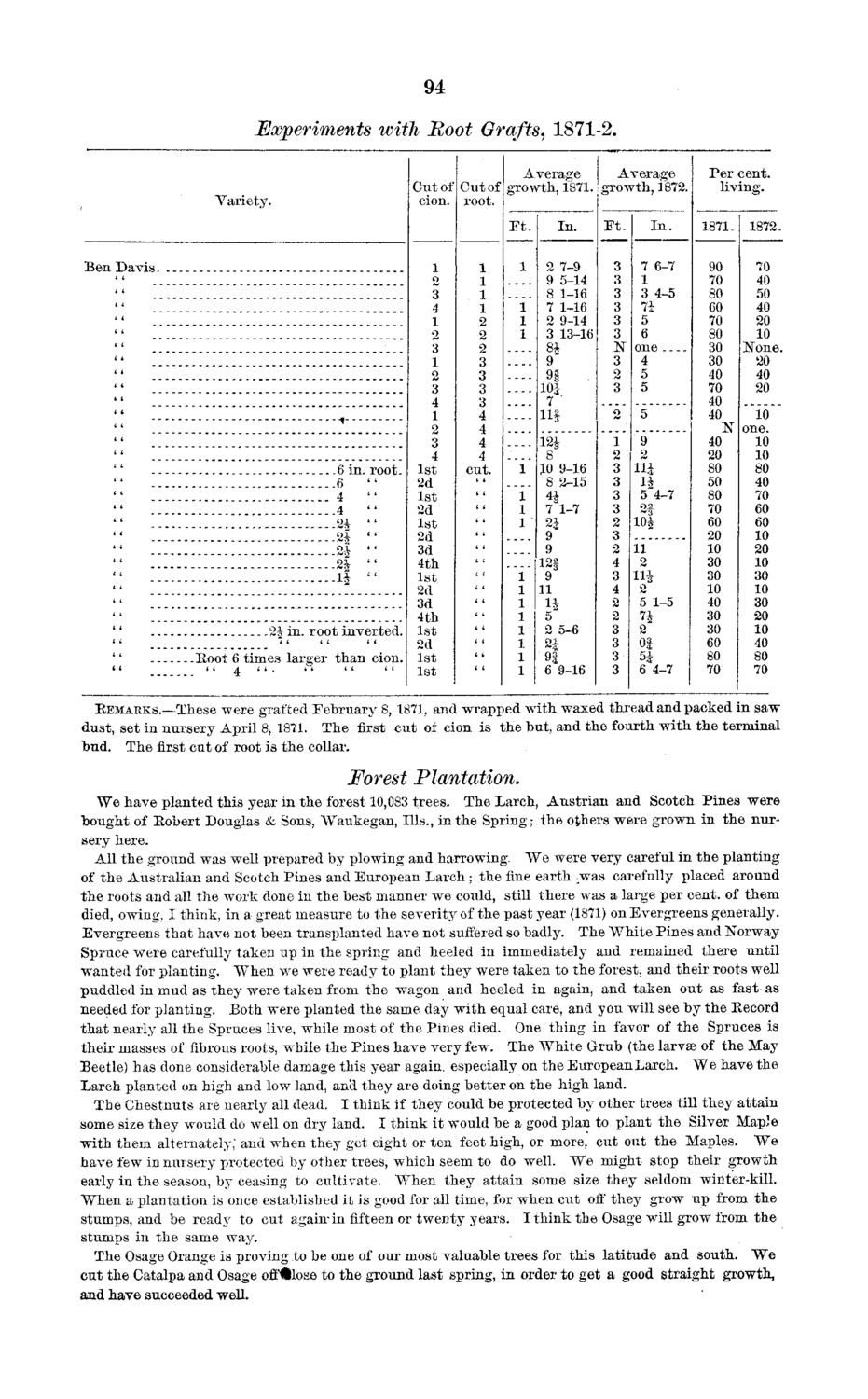Caption: Board of Trustees Minutes - 1873
This is a reduced-resolution page image for fast online browsing.

EXTRACTED TEXT FROM PAGE:
94 Experiments with Boot Grafts, 1871-2. Variety. Average Average C u t of C u t of g r o w t h , 1871. g r o w t h , 1872. cion. root. Ft. P e r cent. living. 1871. 90 70 80 60 70 80 30 30 40 70 40 40 40 20 80 50 80 70 60 20 10 30 30 10 40 30 30 60 80 70 1 In. 2 7-9 9 5-14 8 1-16 7 1-16 2 9-14 3 13-16 8i 9 9| 10£ 7 ' 11* 12* 8 JO 9-16 8 2-15 4* 7 1-7 9 9 12f 9 11 H5 2 5-6 2-1 9| 6 9-16 Ft. In. 1872. 70 40 50 40 20 10 None. 20 40 20 10 one. 10 10 80 40 70 60 60 10 20 10 30 10 30 20 10 40 80 70 Ben Davis 1 o 3 4 1 2 3 1 o it 1 44 6 in. root. 6 4 " 4 " " ;; 44 n " :;::::::;;;:;;:;;::::;:::;;:2i " H " 21- in. root inverted. Hoot 6 times larger than cion. " 4 "• 2£ 21 " '' '' " 44 3 4 1 2 3 4 1st 2d 1st 2d 1st 2d 3d 4th 1st 2d 3d 4th 1st 2d 1st 1st 1 1 1 1 2 2 2 3 3 3 3 4 4 4 4 cut. 1 1 1 1 7 6-7 3 3 1 3 3 4-5 3 7i 3 5 3 6 N one 3 4 2 5 3 5 2 5 1 1 1 1 ' '' '' '' '' 1 ' < <• '< '< ' 1< 2± '' '' <' '' " 1 1 1 1 1 1 1 1 9 1 2 2 3 iii 3 i* 3 5 4-7 3 2f 2 10£ 3 2 11 4 2 3 Hi 4 2 2 5 1-5 2 7i 3 2 3 0| 3 5k 3 6 4-7 KEMARKS.—These were grafted February 8, 1871, and wrapped with waxed thread and packed in saw dust, set in nursery April 8, 1871. The first cut of cion is the but, and the fourth with the terminal bud. The first cut of root is the collar. Forest Plantation. We have planted this year in the forest 10,083 trees. The Larch, Austrian and Scotch Pines were bought of Eobert Douglas & Sons, Waukegan, Ills., in the Spring; the others were grown in the nursery here. All the ground was well prepared by plowing and harrowing. We were very careful in the planting of the Australian and Scotch Pines and European Larch ; the fine earth .was carefully placed around the roots and all the work done in the best manner we could, still there was a large per cent, of them died, owing, I think, in a great measure to the severity of the past year (1871) on Evergreens generally. Evergreens that have not been transplanted have not suffered so badly. The White Pines and Norway Spruce were carefully taken up in the spring and heeled in immediately and remained there until wanted for planting. When we were ready to plant they were taken to the forest, and their roots well puddled in mud as they were taken from the wagon and heeled in again, and taken out as fast as needed for planting. Both were planted the same day with equal care, and you will see by the Eecord that nearly all the Spruces live, while most of the Pines died. One thing in favor of the Spruces is their masses of fibrous roots, while the Pines have very few. The White Grub (the larvae of the May Beetle) has done considerable damage this year again, especially on the European Larch. We have the Larch planted on high and low land, and they are doing better on the high land. The Chestnuts are nearly all dead. I think if they could be protected by other trees till they attain some size they would do well on dry land. I think it would be a good plan to plant the Silver Maple with them alternately,' and when they get eight or ten feet high, or more, cut out the Maples. We have few in nursery protected by other trees, which seem to do well. We might stop their growth early in the season, by ceasing to cultivate. When they attain some size they seldom winter-kill. When a plantation is once established it is good for all time, for when cut off they grow up from the stumps, and be ready to cut again-in fifteen or twenty years. I think the Osage will grow from the stumps in the same way. The Osage Orange is proving to be one of our most valuable trees for this latitude and south. We cut the Catalpa and Osage off#lose to the ground last spring, in order to get a good straight growth, and have succeeded well.
|